INTRODUCTION
Landscape design is both art and organization. Anyone can plant trees or shrubs in a row, but that isn‟t a designed landscape. Landscape design is placing plants and structures in ways that organize and enrich an outdoor space to have agreeable and useful relationships with the natural environment. A good design makes the best use of the space available and the most of the site‟s natural features and advantages. It will often minimize the challenges of a site.
A beautiful landscape is only one result of a good design. A water-efficient, low-maintenance landscape offers many benefits:
- Increases home value
- Lowers water bills
- Conserves natural resources
- Decreases energy use
- Decreases air pollution
- Reduces heating and cooling costs
- Reduces stormwater and irrigation runoff
- Reduces landfill inputs
- Reduces labor and maintenance costs
- Extends the life of water resources
- Expands living space at lower cost than comparable “inside” space
FACTORS INFLUENCING A LANDSCAPE DESIGN
1. The lot and its characteristics
Each property has natural resources onsite. These might be mature trees, a pond, rock outcroppings or interesting variations in the terrain. There might be a gorgeous view to accentuate. Many properties also have problems, such as unsightly buildings nearby or drainage issues. There might be overcrowded trees or poor soils. Some slope to the terrain of a property creates interest, while a steep slope could be a distinct disadvantage.
2. Climate
Climate includes sunlight, precipitation, wind and temperature. These conditions determine how the land can be used and what can be planted. Each lot also has its own microclimates – areas that can be hotter/cooler or windier/shadier than other parts of the yard. Southern and western exposures are the hottest, while northern exposures are the coolest. Sun and shade patterns change with the seasons. In northern Nevada, most of our precipitation comes in the winter, often as snow. Winds are often strongest in unprotected areas, and temperatures vary with location. “Success will require that you work with, rather than fight, the local environment” (Love et al., 2009).
3. Use Areas
Use areas reflect family needs and wants. Do you want a vegetable garden and compost area? Do you need a place for children or pets to play or for you to entertain? Perhaps you require a place to park a recreational vehicle. Use areas may be public, such as the view from the street, or private, available only to the family with a deck, patio or porch for sitting. Some use areas are for storage and work, providing a place for garbage, oil tanks, garden tools and equipment.
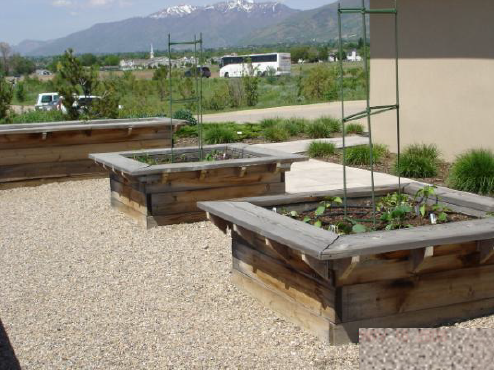
What do you need in your landscape?
4. Family growth
A successful landscape grows with the family. When children are young, they need large spaces to play where they can‟t damage the plants. More sophisticated landscaping can occur as children mature.
5. Maintenance
The simpler the design, the less there is to maintain. Most people want to enjoy their landscape without doing a lot of work. Low maintenance yards have small but functional turfgrass areas, efficient irrigation systems, mulches on bare ground and hardy plants adapted to an arid climate. The more plant needs are supplied by the site, the less maintenance is required by the homeowner.
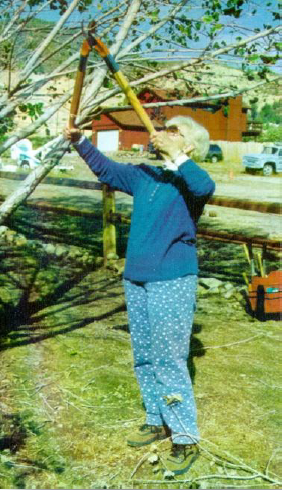
How much maintenance do you want to do?
6. The budget
Decide how much of the family budget can be allocated to the landscape design, both in the immediate future and the long term. Often it is more cost-efficient to phase a project over a period of years, with some professional help in the initial processes, such as soil preparation, landscape installation and irrigation design.
POTENTIAL GOALS FOR THE LANDSCAPE
Landscape designs should be aesthetically pleasing, but there are also many practical things to consider. In Nevada‟s arid climate, landscapes should be water-efficient to cut down on outdoor water usage. Further, homeowners rarely realize that much of Nevada is at risk for wildfires. Landscape design techniques are available to help make a property more water-efficient and fire-safe.
Another consideration is conserving soil by preventing erosion. Good soil is a valuable resource on a property. Attracting wildlife may be a goal for some people, while others aren‟t interested in some of the less desirable animals, such as skunks, voles, ground squirrels or bears.
With rising food prices, edible landscaping deserves serious consideration. Adding edible plants such as fruit trees, berry bushes, herbs and vegetable gardens to the landscape provides added value for water used. A properly designed landscape can help reduce weeds and dust, control temperatures and alleviate the wind.
SITE PLANNING
Site planning is important in designing a landscape. It requires taking a long-term look at the site and deciding what you need and want in a landscape now and in the future. Planning will help you determine the location of structures, such as fences or sheds, and the flow of people and vehicles throughout the site. Walkways, driveways, paths and parking areas control the flow of onsite traffic. These non-plant structures are known as “hardscape.”
WATER-EFFICIENT LANDSCAPING
Often known as a xeriscape™ (Denver Water, 2011) from the Greek word xeros, meaning “dry” plus “landscape,” water-efficient landscaping emphasizes use of low-water-requiring plants and zoning such that plants with similar needs are grouped together within an irrigation zone (Ellefson et al. 1992, Kratsch, 2011). While some parts of the country promote “dry gardening,” emphasizing the use of plants that require only the amount of rainfall available in a specific region, this practice would be difficult in the arid climate of northern Nevada. With less than 7 inches of precipitation annually, very few plants would survive in Nevada‟s built landscapes without at least some irrigation. Plants native to the region survive without irrigation in their wild habitat, but they occur in the exact location that supports their growth, near a source of water like a stream or seep, or they have exceptionally long root systems that can access very deep water tables. These conditions are rarely available in our built environments, so we must focus on irrigating the plants in our landscapes as efficiently as possible to conserve water.
In the Intermountain West, we use approximately 321 gallons of water per person per day (Utah Division of Water Resources, 2003); this includes both indoor and outdoor use. Over the summer, a typical lawn consumes 10,000 gallons of water (Vickers, 2001). In the Reno, Nev. area, with an average annual precipitation of only 7 inches, outdoor irrigation can account for 70 percent of total household water use (EPA WaterSense Program, 2011). With the rising costs of water treatment, we cannot afford to waste water.
The seven principles of water-efficient landscaping are based on planning and design, soil analysis and improvement, practical turf areas, appropriate plant selection, efficient irrigation, mulching and appropriate maintenance.
A landscape can be water-efficient when you:
- Group plants according to their water needs
- Use native and drought-adapted plants (Table 1)
- Limit turfgrass areas to those needed for practical uses, such as children‟s play
- Schedule irrigation wisely
- Keep soil healthy
- Take good care of plants
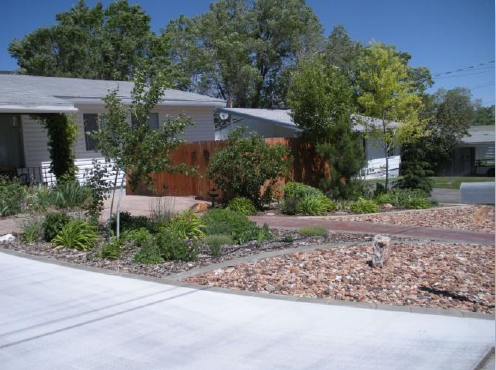
One way to conserve water is to reduce or eliminate turfgrass where it is not functional.
FIRESCAPING
Firescaping is landscape design that reduces house and property vulnerability to wildfire. The goal is to develop a landscape with a design and choice of plants that offer the best defensible/survivable space and that enhance the property. Another goal is to surround the house with hardscape and plants that are least likely to burn. Appropriate manipulation of the landscape can make a significant contribution toward wildfire survival.
Through proper plant selection, placement and maintenance, you can diminish the possibility of ignition, lower fire intensity and reduce the rate at which a fire spreads. The first 30 feet around a home is the most critical defensible space, where fuels are kept to a minimum and plants are kept green and well-pruned. This is a good location for well-irrigated annual or perennial flowers. Other choices for this zone are low-growing deciduous plants and irrigated lawn. Keep in mind, though, that a dry, dead lawn will provide fuel and could potentially spread a fire to your home.
When planning for tree placement for wildfire defense, remember the tree‟s size at maturity. Keep tree limbs at least 15 feet from chimneys, power lines and structures. Minimize use of evergreen shrubs and trees within 30 feet of a structure. Junipers, other conifers and broadleaf evergreens contain oils, resins and waxes that make them burn with great intensity. Use these, ornamental grasses and large deciduous shrubs sparingly in this area because they can be highly flammable. For this sensitive area, select “fire-smart” plants that are low growing and have high moisture content (Skelly and Smith, 2007).
Homes on slopes with extensive native brush or ornamental vegetation will require more defensible space than a house on a flat lot with little vegetation around it. Nonflammable hardscape and water features can act as fuel breaks, which are a vital component in a firescape design.

Landscape designed for water efficiency and wildfire defense.
URBAN HEAT ISLANDS
Some people, in the name of water conservation and wildfire mitigation, minimize or eliminate the plants from their landscape. They may plant a tree or two in the middle of a paved or rock-mulched area to reduce the irrigation water required. However, trees surrounded by rock or pavement will be stressed in summer by reflected heat and light. All the water in the world will not keep these trees healthy.
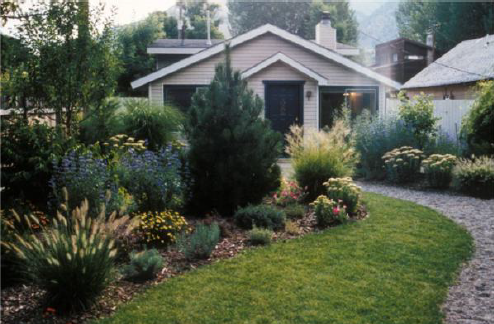
Landscapes in arid areas can be beautiful. Source: Water-Efficient Landscaping in the Intermountain West, Utah State University Press. Landscape designed by Anne Spranger.
Substituting hardscaping for plants does save water but can also create mini heat islands in our urban areas if taken to the extreme. Hardscaping at the expense of plantscaping raises heating and cooling costs and does not provide comfortable outdoor living areas for the home‟s occupants (Rosenberg et al., 2011).
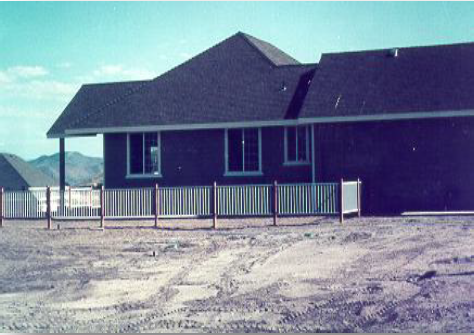
This landscape conserves water, but will make the house hot and cause erosion problems.
Table 1. Some wise plant choices for northern Nevada.
Perennial flowers/foliage
Annual flowers (USDA Hardiness Zone Rating undetermined)
Sources: Cerny, 2003; Kratsch, 2011; Mee et al., 2003; Panter, 2003; Skelly and Smith, 2007. Note: This list is not all-inclusive. It provides information on some of the desirable plants that could be used. For more extensive lists, see the references listed at the end of this publication.
CONCLUSION
Designing beautiful, water- and fire-smart landscapes in northern Nevada can be a challenge, but one worth pursuing. The benefits include saving money, protecting your property and creating space around your home that is comfortable, functional and attractive. A well-designed landscape can make the most of the charms and challenges a site has to offer. Investing in good water- and fire-conscious landscape design advice at the outset will prevent costly retrofitting later and adds as much as 15 percent to the value of a property.
REFERENCES
Cerny, T.A., D. Amundsen, L. Cox. 2003. Annuals for Utah Gardens. Utah State University Extension Publication HG-2003/05.
Denver Water. 2011. DW.
Ellefson, C., T. Stephens and D. Welsh. 1992. Xeriscape™ gardening – water conservation for the American landscape. MacMillan Publishing Company. New York.
EPA Water Sense program. 2011. EPA.
Kratsch, H.A. 2011. Water-Efficient Landscaping in the Intermountain West. Utah State University Press. Logan, Utah.
Love, S., K. Noble and S. Parkinson. 2009. Gardening strategies for short-season, high-altitude zones. University of Idaho Extension. Bulletin 859.
Mee, W., J. Barnes, R. Kjelgren, R. Sutton, T. Cerny and C. Johnson. 2003. Water Wise Native Plants for Intermountain Landscapes. Utah State University Press, Logan, Utah.
Panter, K. 2003. Landscaping: Water-Wise Wyoming Gardens. University of Wyoming Cooperative Extension Service Publication B-1143.
Rosenberg, D.E., K. Kopp, H.A. Kratsch, L. Rupp, P. Johnson and R. Kjelgren. 2011. Value Landscape Engineering: Identifying Costs, Water Use, Labor, and Impacts to Support Landscape Choice. Journal of the American Water Resources Association (JAWRA) 47: 635-649.
Skelly, J.A. and E. Smith. 2007. Choosing the right plants for northern Nevada’s high fire hazard areas. University of Nevada Cooperative Extension Publication EB-07-01. Utah‟s M&I Water Conservation Plan. 2003. Utah Division of Water Resources.
Vickers, A. 2001. Handbook of Water Use and Conservation. WaterPlow Press. Amherst, Massachusetts.
Kratsch, H. and Skelly, J.
2015,
Designing Landscapes for Northern Nevada's Arid Climate,
Extension | University of Nevada, Reno, SP-11-15


